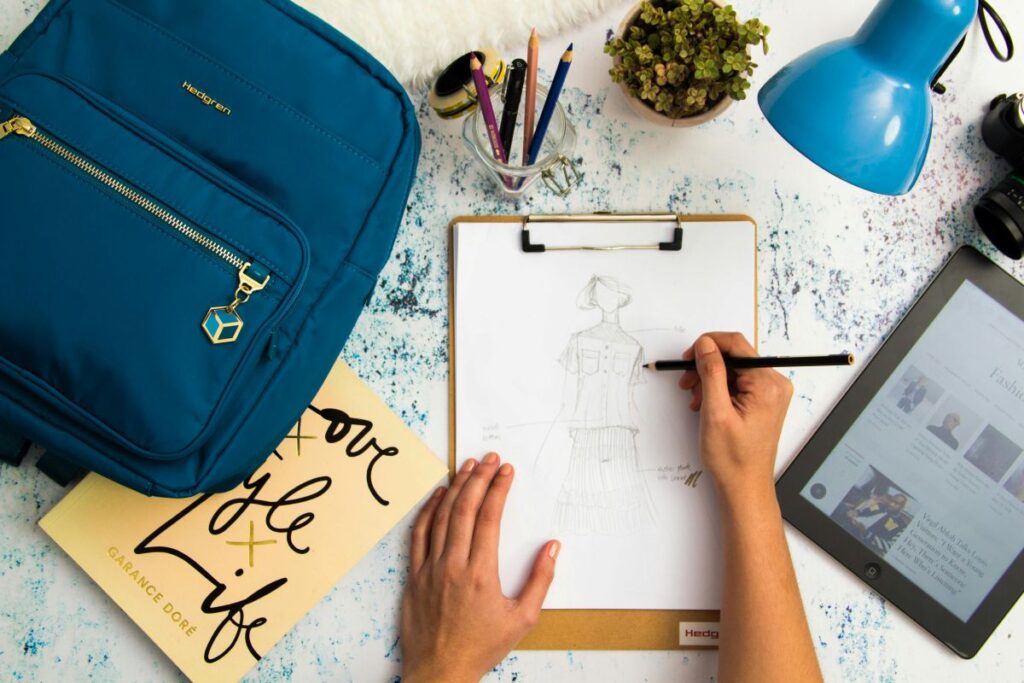What happens when you lock studios full of designers, makers, and fashion design enthusiasts together for 24 hours and give them just one central theme? At last week’s designMT Fashion Jam, the answer was equal parts chaos, creativity, and caffeine. Held in collaboration with MCAST, and supported by the Chamber of Fashion Malta and the Valletta Design Cluster, the first edition of this Malta Crafts Foundation event proved particularly successful.
The event took place at Valletta Design Cluster between 9–10 August, and the theme, ‘Green is the new Black’, was designed to show a consideration of environmental sustainability, as well as aesthetic quality. While incorporating the literal colour green was optional, embedding sustainable principles into the design process was a non-negotiable requirement.
“If the Fashion Jam proved anything, it’s that a day in the hands of creative minds can reinvent not just your wardrobe, but your idea of what sustainable fashion can be.”
On Sunday morning, each team presented their concepts to a panel of judges. The panel, comprised of James Dimech, Carla Grima, Caroline Tonna, Luke Azzopardi and Penny Apap Brown, shared their thoughts and advice, and the winner was announced.
In the midst of the intensive 24 hours, I chatted with each team, both during the design and conceptual process and while the judges deliberated on the winning team.
The design process
The teams were divided equally in skill and ability, and each team, composed of five persons, was allocated a studio space within the Valletta Design Cluster and worked on developing a mood board and concept sketches.
During our chat, Team A, comprised of Tonya Lehtinen, Gabriella Lukacs, Diego Mirabile, Ruslana Grima and Saviour Azzopardi Cachia Castelletti, discussed their holistic approach to sustainable design. This team chose to showcase the deadstock material they used, stating, ‘we are working with what the material is giving us’. The garment transformed between a hoodie or a simple kaftan.
The designed garment, constructed from fine-fibre fringes, is reminiscent of the weaves traditionally found in Maltese furniture, now reimagined to suit the team’s wearable concept. Through its abstract movement, the fabric played with the notions of modesty and balanced ideas of concealing and revealing. They tackle the principle of sustainability very directly, by setting aside traditional silhouette pattern cutting with the aim to produce an almost totally zero waste design.
Team B, comprised of Gabriel Grima, Jelena Milanovic, Martín Joel Gomez Silva, Sarah Camilleri and Abigail Farrugia, centred their final concept around modularity. During our chat, the group discussed standardisation and producing a garment that is easily reproduced, sustainable and adaptable, with multiple ways to wear and use it.
The team set out to design clothing that could support the needs of the modern, everyday wearer, while staying true to the core principle of sustainability. They refined both concept and design ahead of their presentation. When we spoke about the fabric, they emphasised that the true priority lay in the piece’s modularity and standardisation.
The third team was comprised of John Peel, Yentl Cuschieri, Kayleigh Camilleri, Florence Lucie Ihemadu and Ramona del Valle Mansilla. Upcycling and adaptability sat at the heart of their design philosophy. Denim was selected for its durability, practicality, and the stark reality that producing jeans consumes vast amounts of water.
The team’s initial concept centred on deconstruction, breaking down existing garments to give them new life. But over the course of the 24-hour challenge, their idea evolved into an outfit that incorporated both aesthetic quality and Maltese heritage.
The final team, Team D, focused on simplicity and practicality. The team members were Eszter März, Daniela Priehyba Camilleri, Mohammad Abdul Kader, Maxine Calleja and Raquel Pace. The principles of functionality and multi-use were also at the forefront of their design concept.
During our chat, we discussed the possibility of garments that could transform from morning to evening wear; pieces that adapt to settings, needs, and moods. . They spoke about clothing not just as something worn, but as a tool for convenience, sustainability, and personal expression, blurring the lines between practicality and style.
A common thread among the groups was their interest in adaptability and reusing the same material. But it raised a question: when that material eventually reaches the end of its life, had they considered how it would be discarded? And if so, was the material itself sustainable? Only a few teams had taken that extra step.
Post-presentations
By Sunday morning, the atmosphere had subtly changed. Each team was focused on perfecting their presentations, making final adjustments to garments and samples. Once the last design was presented, the energy shifted entirely; a collective exhale after 24 hours of creative intensity.
While the judges deliberated, I made the rounds, checking in with each team to reflect on their process, the challenges they faced, and the unexpected turns their ideas had taken.
Team A, later praised by the judges for their garment’s aesthetic uniqueness, credited good communication for a smooth process and a strong finish. Team B stole the show with a reversible, six-in-one dress: part cocktail outfit, part shopping bag; all held together with an open-ended invisible zip, maintaining that sleek, minimalist look.
The third team spoke about the intensity and excitement of working together under pressure and the opportunity to bounce ideas around like a game of creative pinball. Team D took the weekend as a chance to swap skills and soak up the group energy.
In the end, it was Team B who walked away victorious, after presenting a design that was both stylish and practical. If the Fashion Jam proved anything, it’s that a day in the hands of creative minds can reinvent not just your wardrobe, but your idea of what sustainable fashion can be.
We should all be looking forward to seeing these designs brought to life.
